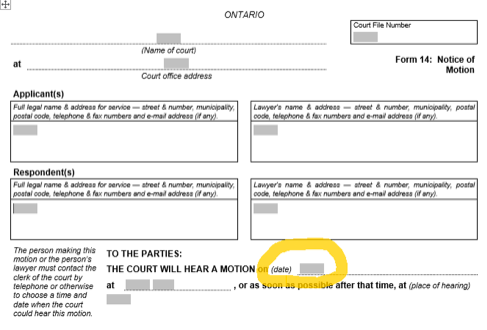Help! – I’ve Just Been Served!
What To Do When You Receive Documents In A Family Law Proceeding
Introduction
In the normal course of family law proceedings in Ontario, steps in the court process are initiated by one party filing documents with the court and providing the other party with a copy of the court documents being filed. A party being given a copy of court documents is called “service,” and there are rules that dictate the service process under the Family Law Rules.
On rare occasions, a judge may allow a portion of the court process to proceed without any notice to the other party; such a proceeding is called ex parte and is reserved for special situations where there would be some sort of harm if the other party was notified of the court proceedings immediately. In an ex parte proceeding, the other party is not served with a copy of court documents beforehand.
Also, under certain circumstances, it may be the court serving documents on the parties rather than one party serving the other.
First Step – Note The Date and Manner of Service
The very first thing to do when you receive a copy of court documents is to note when and how you received these documents. This is very important, as the date of service often dictates when your response is due. If you do not keep track of when you were served, you will not know how much time you have for your response.
Certain documents also have to be served within a minimum amount of time before a corresponding court appearance under the Family Law Rules. For instance, the documents to bring a motion for a temporary order under Rule 14 of the Family Law Rules must be served “not later than six days before the motion date.” It is important to keep track of when you are served in order to tell if you were served within the allowable amount of time before the corresponding court appearance; if you are not, it is referred to as “short service,” as the period of time between when you were served and the corresponding court appearance is shorter than allowed. Short service could be grounds for an adjournment or a dismissal of a court appearance, so this is very important to pay attention to.
The second important thing to note is how you were served. Was it regular mail, email, courier, left with you, left at your house, left with a different member of your household? The Family Law Rules dictate what methods of service are allowed for different court documents, and if you are not served with the correct method this could again be grounds for an adjournment or a dismissal of a court appearance.
Second Step – What Were You Served With?
There are a variety of different court documents [efn_note] https://www.canlii.org/en/on/laws/regu/o-reg-114-99/latest/o-reg-114-99.html#sec6subsec1.[/efn_note] you could be served with under the Family Law Rules, so it is important to figure out exactly which one you received. The good news is the top right corner of a document should have the form number and name, which lets you know what document it is. For instance, the first page of an Application for general relief shows in the top right corner the form number and name.

If the court documents you receive are lettered forms and not numbered forms, they may be pursuant to the Interjurisdictional Support Orders (ISO) Act and not the Family Law Rules [efn_note]http://ontariocourtforms.on.ca/en/family-law-rules-forms/[/efn_note]. The form letter and name for these documents will not always be in the top right corner, but the first page should still identify the form letter and name.
Third Step – How Much Time Do You Have?
There are two aspects to how much time you have: when your response is due and when the next court appearance is. Not all documents you are served with will involve a court appearance. Sometimes you will be served with multiple documents, and only one will identify when the next court appearance is. It is very important to check every document you receive to make sure you pay attention to any upcoming court dates. For instance, if you are being served with a motion for a temporary order under Rule 14 of the Family Law Rules, you may be served with multiple Form 14A Affidavits and a Form 14 Notice of Motion. Only the Notice of Motion in this example will necessarily tell you when the next court date is.

To figure out when your response is due, you will have to consult the corresponding section of the Family Law Rules for the specific court documents you are served with. Often this will involve counting forward from the date you were served.
Conclusion
The service rules are very important to pay attention to, but they are not easy. Weekends and holidays may affect proper service time. Different documents require different methods of service. The Family Law Rules even has a whole section on how to properly count days for service along with an example. If you have any questions about service, identifying what you were served with, or figuring out when your next court date might be, do not hesitate to contact us with your questions.
The above information is NOT legal advice of any kind, and you should be sure to speak to a qualified family law lawyer about what to do with documents in a family law proceeding. For more information, on how to find justice during a pandemic, call us at 905-273-4588 or email us at contact@kainfamilylaw.com to book a free 30-minute consultation with one of our experienced family law lawyers at Kain & Ball Family Law.

